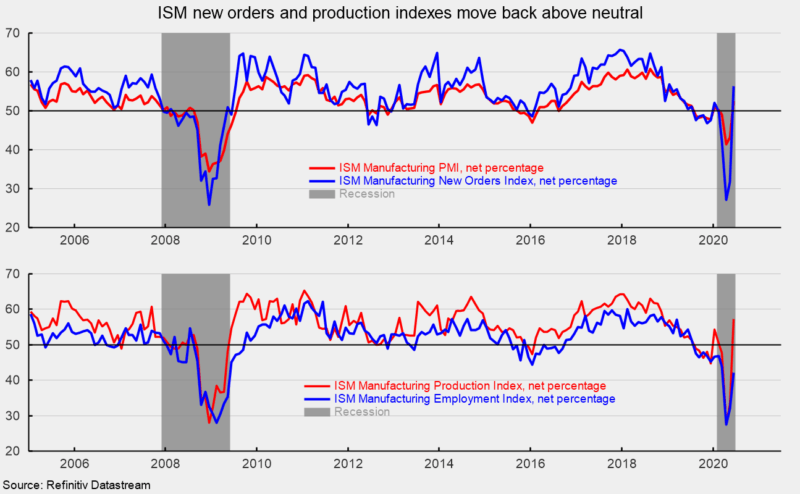Manufacturing Sector Starting to Grow Again
The Institute for Supply Management’s Manufacturing Purchasing Managers’ Index showed dramatic improvement, registering a 52.6 percent reading in June, up from 43.1 percent in May and the first reading above the neutral 50 threshold since February. The June result follows three months in a row in the 40s (see top chart). Overall, the report notes, “June signifies manufacturing entering an expected expansion cycle after the disruption caused by the coronavirus (COVID-19) pandemic. Comments from the panel were positive (1.3 positive comments for every one cautious comment), reversing the cautious trend which began in March.”
The composite Purchasing Managers’ Index gain of 9.5 percentage points was a month-over-month rate of change not seen since 1980 while several of the key components of the Purchasing Managers’ Index posted “gains not seen in modern times.” The New Orders Index came in at 56.4 percent, up from 31.8 percent in May, a jump of 24.1 percentage points and the first reading above 50 since January (see top chart). The New Export Orders Index came in at 47.6 percent in June, up 8.1 percentage points from a 39.5 percent result in May. The Backlog-of-Orders Index came in at 45.3 percent in June, up from 38.2 percent in May and suggesting a fourth consecutive month of decline in backlogs. The backlogs index has been below 50 for 13 of the past 14 months.
The Production Index was at 57.3 percent in June, up from 33.2 percent in May and a record-low 27.5 in April. Thirteen industries reported growth in the latest month while three reported contraction.
The Employment Index rose 10.0 percentage points to 42.1 percent in June, versus 32.1 percent in May and 27.5 in April, the lowest reading since June 1949 (see bottom chart). The below-neutral result suggests employment in manufacturing may have fallen again in June. The Bureau of Labor Statistics’ Employment Situation report for June is due out on Thursday, July 2 (one day early due to the Independence Day holiday being celebrated on Friday July 3). However, despite the weak reading from the ISM survey, consensus expectations are for a gain of 3 million nonfarm-payroll jobs including the addition of 311,000 jobs in manufacturing. The unemployment rate is expected to fall to 12.3 percent from 13.3 percent in May.
The Supplier Deliveries Index, a measure of delivery times from suppliers to manufacturers, eased back, falling to 56.9 percent from 68.0 percent in May. Slower supplier deliveries are usually consistent with stronger manufacturing activity. However, the slower deliveries in recent months have been more a result of supply chain and logistical constraints. According to the report, “Suppliers continue to struggle to deliver, although at a slower rate compared to May. Plant shutdowns, transportation challenges and continuing difficulties in importing parts and components continue to be factors, but to lesser degrees. The Supplier Delivery Index currently reflects a healthy supply/demand balance.”
The Prices Index rose 10.5 percentage points to 51.3 percent in June from 40.8 percent in May. Higher prices were reported for: aluminum; caustic soda; copper; crude oil; diesel fuel; ethanol; natural gas; personal protective equipment (PPE) — masks; steel — hot rolled; steel — scrap; and steel products. Weaker prices were reported for: aluminum; diesel fuel; methanol; nylon; packaging materials; plastic products; resins; solvents; and steel products.
Customer inventories in June are still considered too low, with the index remaining below 50 at 44.6 percent versus 46.2 percent in the prior month (index results below 50 indicate customers’ inventories are too low). The index has been below 50 for 45 consecutive months.






